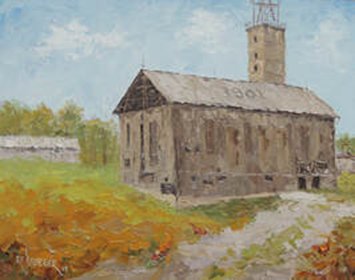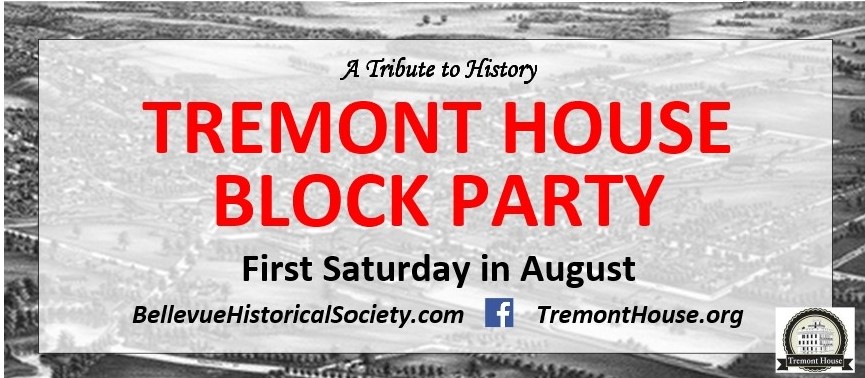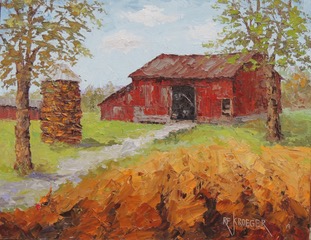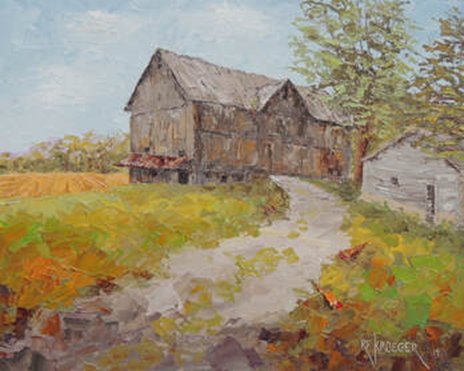
 Auction at The Tremont House Block Party on August 3rd will feature four of Bob Kroeger’s paintings, representing barns in Erie and Huron Counties, to be auctioned, with proceeds benefiting both the Historical Society and Art at 106, Bellevue’s local Artists’ Guild and Gallery Shop. Erie County barns are the Pickett Cherry Barn, now dismantled, which drew customers from all surrounding states to its Portland Rd site, and on Strecker Road, the Tommas barn, a marvelous old fellow with an empty corn crib that begged to be full again, which the painting complied. In Huron County, the Schwiefurt barn on Sandhill Road which rocked to many dancing feet over the years, and the Roeder barn on Route 20, west of Monroeville, recording its racing history as well as its farming origins.
Auction at The Tremont House Block Party on August 3rd will feature four of Bob Kroeger’s paintings, representing barns in Erie and Huron Counties, to be auctioned, with proceeds benefiting both the Historical Society and Art at 106, Bellevue’s local Artists’ Guild and Gallery Shop. Erie County barns are the Pickett Cherry Barn, now dismantled, which drew customers from all surrounding states to its Portland Rd site, and on Strecker Road, the Tommas barn, a marvelous old fellow with an empty corn crib that begged to be full again, which the painting complied. In Huron County, the Schwiefurt barn on Sandhill Road which rocked to many dancing feet over the years, and the Roeder barn on Route 20, west of Monroeville, recording its racing history as well as its farming origins.
The Tremont House Block Party is held on North West Street and in the alley behind the Tremont House, in the center of Bellevue, from 3 to 8 p.m. The paintings will be auctioned at 5:00, by Baker, Bonnigson Auctioneers. Join us for the festivities! Food, live music, wine and craft beer tastings, historic displays, a beam signing in the Tremont House, and raffles round out the events of the day.
Click Here to Print Absentee Bid Form
Click Here to Print Phone Bid Form
“Prisoners of War” (pictured above)
In the spring of 2018 – a year before my barn tour of Erie County – my barn scout Mel sent me a photo of this unusual barn and told me its story, which was the first time I’d heard that the United States took in POWs during WWII. But let’s begin at the beginning.
The barn – now dismantled – had a slate roof with the date of 1901, probably signifying when the barn was built. The farm may have been started earlier than that, as many were in Ohio’s northwest. And the original family may have been the Ohlemachers.
But eventually the Picketts took over the farm and planted many orchards of cherry trees – all kinds of them – sour, sweet, and in-between varieties. By the 1930s the trees were ready for harvest, which began a family tradition and gave work to many, not only locals but also to migrant workers traveling from one site to another. According to 87-year-old Bill Oddo, a local historian and founding member of the Bellevue Historical Society, whom I interviewed, each morning a flatbed truck would pick up workers throughout the region and transport them to the orchards during picking season, which lasted five to six weeks each summer. The migrant workers from out of town would be allowed to live in grain bins inside the barn. Mrs. Pickett would cook for them with her daughter Eileen, and eventually her granddaughters, Jean and Sue,helped with cooking and serving.
Bill, a teenager then, worked summers on this farm from about 1943 to 1947, picking cherries with his five brothers, closely supervised by their mother, who told them that their father didn’t make enough money in a factory job and that the extra cash would come in handy. Apparently, according to Bill, this amused his dad and may or may not have been true but it taught the children the value of hard work. Each child was supposed to pick 20 buckets – with a team goal of 100 buckets a day. One day, Bill said, they did out earn dad’s daily wages. But Bill – and many of the other teenaged boys – preferred working inside the barn where the cute girls worked – two or three dozen of them, preparing and pitting the cherries and then measuring them out into the buyers’ buckets or boxes. Boys will be boys.
The children also learned another valuable lesson. During the war years, American troops overseas simply could not handle the vast numbers of German and Italian POWs; so they transported them to our soil.
According to some sources, over 435,000 POWs – in 46 states and Alaska – were held here during those years, an exodus that began in August of 1942, when Britain could not handle its 273,000 prisoners. Churchill convinced our leaders to take 150,000 of them to start and, in the middle of 1943, when he visited Washington for a war conference, he shared the Queen Mary ocean liner with several thousand POWs.
During cherry harvest season, guards would load buses with prisoners from nearby Camp Perry in Port Clinton and bring them to the farm. Remember, in the early stages of the war the Germans, Italians, and Japanese were winning. Our Pacific fleet was ravaged. The Japanese occupied two of the Aleutian Islands – where my own father had been stationed – and the Germans were turning Britain into a bombed out graveyard. U-boats patrolled our eastern coast and torpedoed ships. So, many Americans weren’t pleased to provide food and shelter for these troops, though they treated them according to the requirements of the Geneva Convention. Unfortunately the Germans didn’t treat our POWs equally well in their camps.
According to locals who interacted with these POWs, including Bill and his family, each POW had a daily quota of 20 buckets of cherries. When the Germans reached their quota, they’d return to the bus and wait until it was time to return to Camp Perry. On the other hand, the Italian POWs were more amiable than their stoic German allies and, sharing a common culture with local Italian immigrants, many returned to settle in these counties after the war.
Behind the barn site stands a large cement tower with metal rigging and antennas, a structure that, according to Bill, the government built in 1946. My barn scouts explained that it was a booster radio transmitter that was used to enhance signals between Cleveland, Toledo, and Detroit.
But all good things come to an end and eventually cherry trees stop bearing fruit – usually after 15-30 years. Summer work shut down and the trees became ornamental. Farm ownership passed from patriarch Harold Pickett to his son Charles. Around 2010 the land was bulldozed, removing the trees, and the farm was sold at auction in 2012, when present owner Kevin Schaeffer purchased it. A history buff himself, and mindful of the heritage he inherited when he bought the farm, Kevin saved some barn siding – after the barn was dismantled in 2018 – and provided it for the framing of this painting, one that’s captured a story of our past, a memory of the POWs who once worked here, and another reminder of the brave men and women who captured them during WWII. Yes, that was the Greatest Generation. Let’s never forget them.
For more information on artist Robert Kroeger, go to https://barnart.weebly.com/

 Auction at The Tremont House Block Party on August 3rd will feature four of Bob Kroeger’s paintings, representing barns in Erie and Huron Counties, to be auctioned, with proceeds benefiting both the Historical Society and Art at 106, Bellevue’s local Artists’ Guild and Gallery Shop.
Auction at The Tremont House Block Party on August 3rd will feature four of Bob Kroeger’s paintings, representing barns in Erie and Huron Counties, to be auctioned, with proceeds benefiting both the Historical Society and Art at 106, Bellevue’s local Artists’ Guild and Gallery Shop.
Erie County barns are the Pickett Cherry Barn, now dismantled, which drew customers from all surrounding states to its Portland Rd site, and on Strecker Road, the Tommas barn, a marvelous old fellow with an empty corn crib that begged to be full again, which the painting complied. In Huron County, the Schwiefurt barn on Sandhill Road which rocked to many dancing feet over the years, and the Roeder barn on Route 20, west of Monroeville, recording its racing history as well as its farming origins.
The Tremont House Block Party is held on North West Street and in the alley behind the Tremont House, in the center of Bellevue, from 3 to 8 p.m. The paintings will be auctioned at 5:00, by Baker, Bonnigson Auctioneers. Join us for the festivities! Food, live music, wine and craft beer tastings, historic displays, a beam signing in the Tremont House, and raffles round out the events of the day.
Click Here to Print Absentee Bid Form
Click Here to Print Phone Bid Form
“The Crib” (pictured above)
This was the first barn we visited on a soggy April day in northwestern Ohio, beginning in Bellevue, a unique Ohio city that boasts having four counties inside its city limits – Erie, Huron, Seneca, and Sandusky: the first three named after local Indian tribes and the last derived from a Wyandot word meaning “water.” Lord knows there was a lot of it today – fields flooded, some roads impassable and others – that probably should have been flagged as closed – served as challenges for drivers. Would the car get stuck?
Owned by Don Tommas, this barn dates to the early 1900s, evidenced by the wooden peg nails holding the saw-cut beams together. Two trees framed the barn, its weathered red paint giving way to underneath gray, but what caught my eye was a large metal corn crib, sadly empty. I decided to fill it. I also liked the adjacent windmill, but opted to leave it out – only so much room. Two geese – Canadian honkers – ambled in the foreground, but, since this is an American barn, they didn’t merit a spot in the painting.
For more information on artist Robert Kroeger, go to https://barnart.weebly.com/

 Auction at The Tremont House Block Party on August 3rd will feature four of Bob Kroeger’s paintings, representing barns in Erie and Huron Counties, to be auctioned, with proceeds benefiting both the Historical Society and Art at 106, Bellevue’s local Artists’ Guild and Gallery Shop. Erie County barns are the Pickett Cherry Barn, now dismantled, which drew customers from all surrounding states to its Portland Rd site, and on Strecker Road, the Tommas barn, a marvelous old fellow with an empty corn crib that begged to be full again, which the painting complied. In Huron County, the Schwiefurt barn on Sandhill Road which rocked to many dancing feet over the years, and the Roeder barn on Route 20, west of Monroeville, recording its racing history as well as its farming origins.
Auction at The Tremont House Block Party on August 3rd will feature four of Bob Kroeger’s paintings, representing barns in Erie and Huron Counties, to be auctioned, with proceeds benefiting both the Historical Society and Art at 106, Bellevue’s local Artists’ Guild and Gallery Shop. Erie County barns are the Pickett Cherry Barn, now dismantled, which drew customers from all surrounding states to its Portland Rd site, and on Strecker Road, the Tommas barn, a marvelous old fellow with an empty corn crib that begged to be full again, which the painting complied. In Huron County, the Schwiefurt barn on Sandhill Road which rocked to many dancing feet over the years, and the Roeder barn on Route 20, west of Monroeville, recording its racing history as well as its farming origins.
The Tremont House Block Party is held on North West Street and in the alley behind the Tremont House, in the center of Bellevue, from 3 to 8 p.m. The paintings will be auctioned at 5:00, by Baker, Bonnigson Auctioneers. Join us for the festivities! Food, live music, wine and craft beer tastings, historic displays, a beam signing in the Tremont House, and raffles round out the events of the day.
Click Here to Print Absentee Bid Form
Click Here to Print Phone Bid Form
"Kinda Homely” (pictured above)
On our tour of Huron County, barn scouts Mel and Judy introduced me to Debbie Schwiefert, whose brother Craig owns this old barn. The slate roof, though more expensive than traditional wooden shakes, has proven it was a good investment, having protected the barn for over a century.
According to Judy and Debbie – who were interviewed by barn scout Judy Miller – the Seibel family built it in 1912, using lumber from the adjacent woods and moving dirt to form a bank to the upper level. At the time it was the largest barn in Huron County and, even today, it still commands attention with its dimensions of 80 by 100 feet.
Craig’s grandparents, Fred and Marie Koch, bought the farm in 1941, but this story begins before that. Marie, also known as “Granny” Koch, liked to dance and would jump at the chance to go to one, especially when in a barn, as was the case with this one, which held square dances from the 1920s and well into the 1940s. Marie dated Fred’s brother initially but she couldn’t resist Fred’s invitation to barn dances and often would say that “Fred was kinda homely but he took me to all the barn dances, and I loved to dance.” See, there’s more than one way to win a girl’s heart.
Fred and Marie owned The Red and White grocery store in Sandusky for several years but they didn’t like being in that business and began saving their money to buy a farm. One day, by chance, Marie visited the Seibel family and learned that they were about to lose their farm to the auction block for failing to pay taxes, which sadly was not unusual coming out of the1930s and its Great Depression. So, without consulting Fred and realizing a good deal, Marie wrote a check and bought the farm. Fred found out later. As Debbie admitted, “Everyone knew who wore the pants in the family.” And, she wore those pants for a long time, passing away at age 106.
Whereas the Seibels used horses to farm – the old fashioned way of the 1800s – Fred used a tractor, which was much more efficient. His first one was a 1942 Allis Chalmers and his next one, a 1948 model, is still in the barn. His farm prospered, though he stopped farming in the 1960s.
But times changed and the square dances in the barn gave way to Halloween parties that drew hundreds of visitors over the years. After all, haunted barns can be scary! And, even though the barn stores only an old tractor, it remains important to the family, many of whom live close by. They hope that someone will dismantle it and re-build it somewhere. That, of course, is a costly project, but, if it should happen, I’m sure it would bring a smile to Granny Koch’s lips, if she were still around.
For more information on artist Robert Kroeger, go to https://barnart.weebly.com/

 Auction at The Tremont House Block Party on August 3rd will feature four of Bob Kroeger’s paintings, representing barns in Erie and Huron Counties, to be auctioned, with proceeds benefiting both the Historical Society and Art at 106, Bellevue’s local Artists’ Guild and Gallery Shop. Erie County barns are the Pickett Cherry Barn, now dismantled, which drew customers from all surrounding states to its Portland Rd site, and on Strecker Road, the Tommas barn, a marvelous old fellow with an empty corn crib that begged to be full again, which the painting complied. In Huron County, the Schwiefurt barn on Sandhill Road which rocked to many dancing feet over the years, and the Roeder barn on Route 20, west of Monroeville, recording its racing history as well as its farming origins.
Auction at The Tremont House Block Party on August 3rd will feature four of Bob Kroeger’s paintings, representing barns in Erie and Huron Counties, to be auctioned, with proceeds benefiting both the Historical Society and Art at 106, Bellevue’s local Artists’ Guild and Gallery Shop. Erie County barns are the Pickett Cherry Barn, now dismantled, which drew customers from all surrounding states to its Portland Rd site, and on Strecker Road, the Tommas barn, a marvelous old fellow with an empty corn crib that begged to be full again, which the painting complied. In Huron County, the Schwiefurt barn on Sandhill Road which rocked to many dancing feet over the years, and the Roeder barn on Route 20, west of Monroeville, recording its racing history as well as its farming origins.
The Tremont House Block Party is held on North West Street and in the alley behind the Tremont House, in the center of Bellevue, from 3 to 8 p.m. The paintings will be auctioned at 5:00, by Baker, Bonnigson Auctioneers. Join us for the festivities! Food, live music, wine and craft beer tastings, historic displays, a beam signing in the Tremont House, and raffles round out the events of the day.
Click Here to Print Absentee Bid Form
Click Here to Print Phone Bid Form
“Champions” (pictured above)
This barn, now serving another purpose as a motorcycle shop, is a sentimental favorite of folks around Bellevue, which is why my barn scouts selected it for my project. It also revolves around the Roeder family, known for their expertise in motorcycle racing.
George Roeder, whose family owned this old barn, is in the American Motorcyle Association’s Hall of Fame, an honor he fully deserves. His older brother, Charles, apparently instilled this passion into George, who, fibbing about his age, began his professional career at 17 in 1954, even though the AMA lists 18 as the minimum. A natural athlete – and a fearless one – he began to win and win again and again. Three years later, he began the 1957 season with a new Harley-Davidson, which he bought for $100, thanks to the generosity of the Ohio H-D dealers association.
During the 1960s he won eight nationals and became a member of the Harley-Davidson racing team, eventually testing one of their experimental engines. In 1965, using this unproven engine, another testament to his courage, he drove a streamlined H-D 250cc Sprint on the Bonneville Salt Flats in Utah, setting a world record of 177 miles per hour, breaking the previous record of 156 mph. Though this speed record surely excited George, his heart remained in dirt racing, even though he excelled in road racing as well, earning four podium finishes in the Daytona 200 in the early-to-mid 1960s. Roeder never changed his dirt-track racing technique though – by taking most turns with his foot firmly planted on the ground, a style that led to a broken arm in 1968, making him retire … temporarily. When he returned to competition the next year, he broke his ankle.
After he opened the Roeder Harley Davidson distributorship in 1972, also housed in this old barn, located his home town of Monroeville, he slowed down. Two years later, the urge to compete surfaced once again and he returned to racing at the 1974 San Jose Mile.
Unfortunately, the one thing he couldn’t beat took over and, with rising mountains of medical bills, he lost the H-D dealership. He died in 2003, at the age of 66.
However, his racing legacy continued with his sons George II, Will and Jess, champions in their own right. His family continues to run their motorcycle store, Roeder Racing and Service, housed in the same old barn in Monroeville, where they service motorcycles and sell parts and old Harleys.
Their reputation was strong enough to entice the stars of the TV show, American Pickers, to visit the store in early 2016. After Roeder’s daughter learned that American Pickers were coming to Ohio, she sent them a photo of a 1946 Harley Knucklehead motorcycle. Being antique motorcycle buffs, they couldn’t resist, though on their visit they respected the family’s decision not to sell the antique machine. Instead, they bought a 1913 motorcycle engine, an old Harley Hummer motorcycle, and an old H-D shirt for $300 – as well as honoring the family’s rich racing history. Champions all.
For more information on artist Robert Kroeger, go to https://barnart.weebly.com/
- You are here:
-
Home

-
Events

-
Current Events

- BLOCK PARTY



